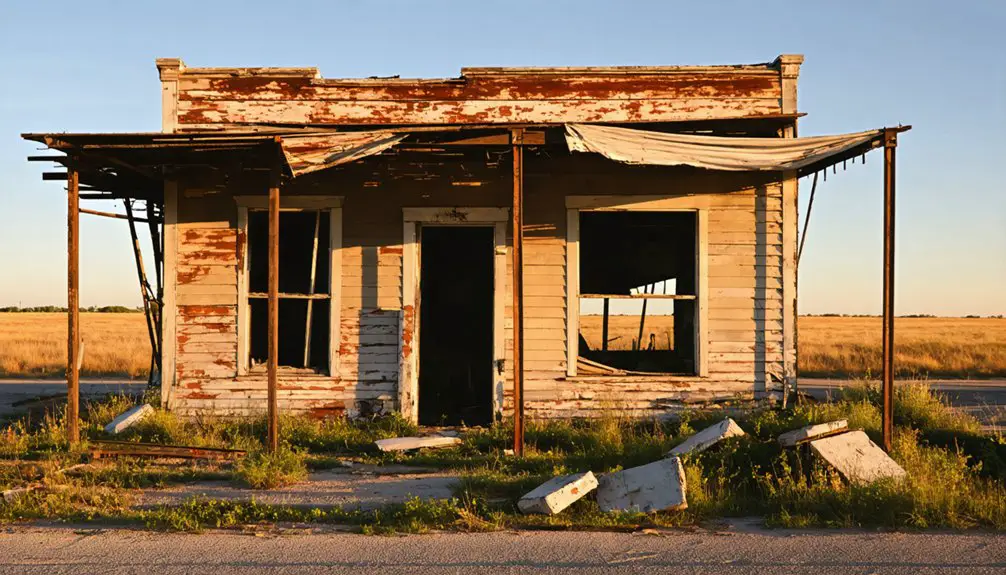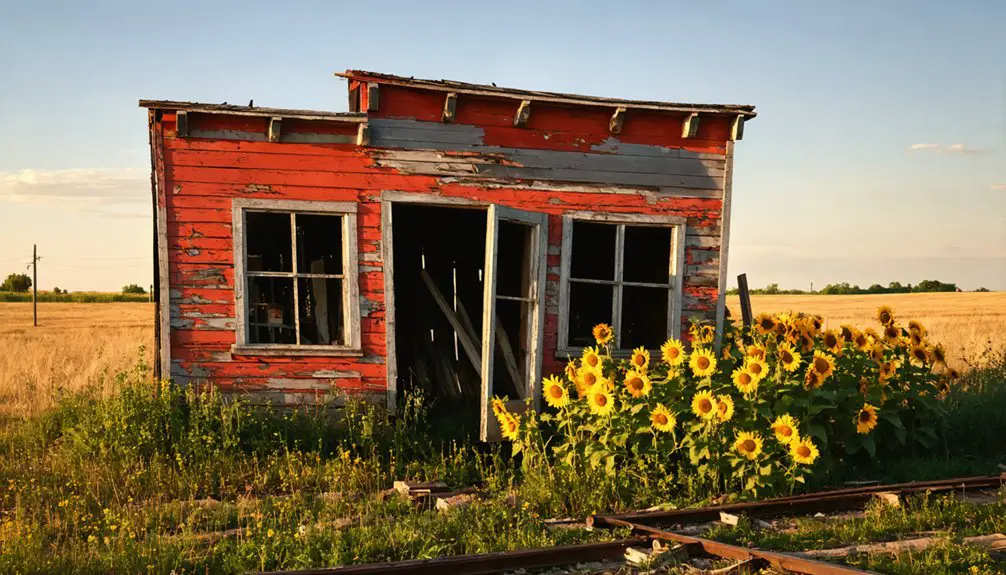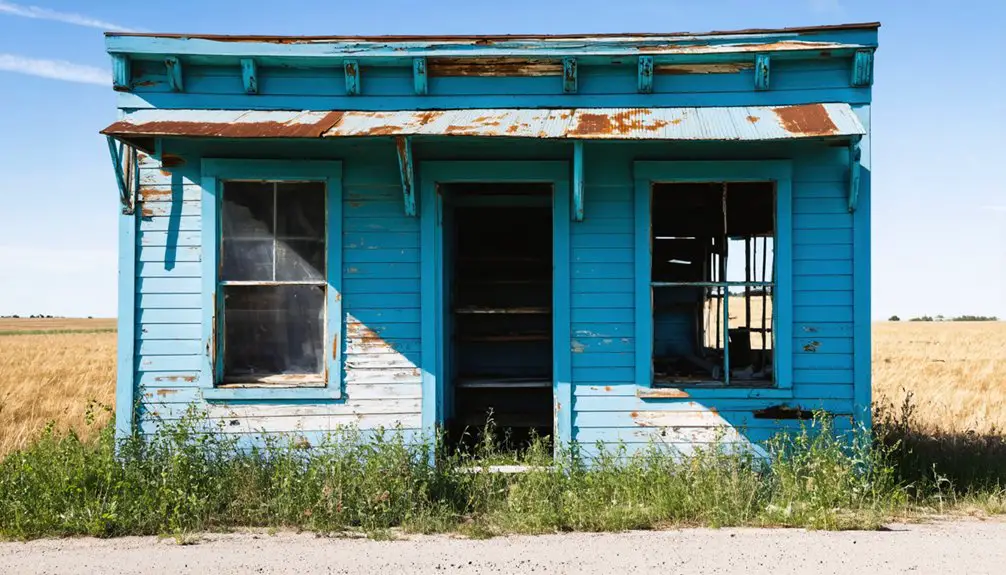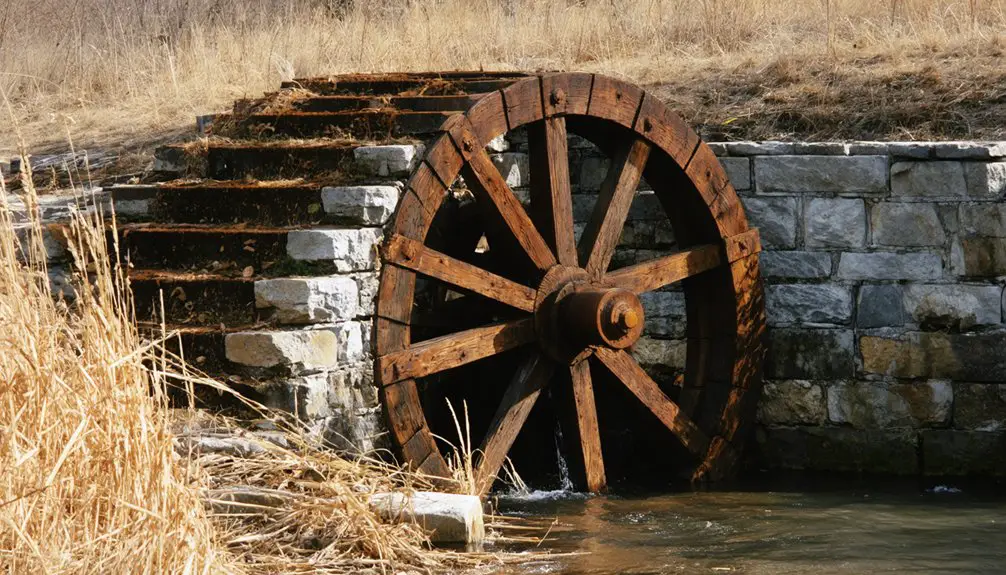You’ll find Minneola’s ghost town story in Franklin County, Kansas Territory, where it emerged from St. Bernard in 1855. The settlement’s ambitious bid to become territorial capital in 1858 led to the infamous “Minneola Swindle,” as Perry Fuller and associates distributed free lots to legislators for votes. Within six weeks, they’d built a legislative hall, hotel, and stores, but legal challenges and drought stripped away Minneola’s promise. The full tale reveals how railroad dreams and political schemes shaped Kansas Territory’s forgotten metropolis.
Key Takeaways
- Minneola was established in 1855 in Franklin County, Kansas Territory, initially as St. Bernard before being rebranded by Perry Fuller.
- The town’s ambitious development included a legislative hall, hotel, and stores built within six weeks during late 1858.
- A political scandal called the “Minneola Swindle” occurred when legislators with property interests voted to make it the territorial capital.
- The settlement failed after losing its capital status, with buildings abandoned and later moved to Ottawa in 1864.
- Severe drought and the Missouri Pacific railroad’s bypass in 1881 ultimately transformed Minneola into a ghost town.
From St. Bernard to Minneola: Origins of a Lost Town
While Kansas Territory wrestled with the slavery question in 1855, J.M. Bernard established a settlement that would leave a complicated town legacy in Franklin County. As the local postmaster, Bernard’s pro-slavery stance created fierce tensions with anti-slavery settlers, ultimately forcing his departure from the community he founded.
You’ll find the settlement’s evolution took a dramatic turn when Perry Fuller and his associates purchased 14 quarter sections of farmland near St. Bernard. They rebranded the location as Minneola, deliberately distancing it from Bernard’s pro-slavery reputation. Historical records show that internal links helped researchers trace the various interpretations of Minneola’s development during this period. The town’s development included lavish buildings such as residences, stores, a hotel, and government structures.
Fuller, who’d previously worked to establish Centropolis, envisioned Minneola as a grand territorial capital. The town’s ambitious transformation reflected the shifting political tides in Kansas Territory, as free-state supporters gained momentum in their fight against slavery’s expansion.
The Grand Vision: Plans for a Territorial Capital
You’ll find that Minneola’s ambitious rise began in late 1858 when town founders purchased 14.5 sections of farmland and distributed elaborate promotional materials showcasing plans for a magnificent territorial capital.
Through strategic distribution of free town stock and land lots to legislators, Minneola’s backers secured votes to designate their fledgling town as the new capital, despite Governor Denver’s veto.
Promised railroad development attracted settlers and fueled initial optimism about the town’s prospects.
Within just six weeks, you’d have witnessed a flurry of construction including a legislative hall, seven-story hotel, and several stores, though this prosperity proved short-lived once the U.S. Attorney General declared the legislative act invalid.
Political Maneuvering and Bribes
During February 1858, Perry Fuller and his associates orchestrated one of Kansas Territory’s most notorious political schemes, known as the “Minneola Swindle.”
By distributing free stock and land lots to territorial legislators through the Minneola Town Company, Fuller secured a two-thirds majority vote (28-9) to establish Minneola as the territorial capital, overriding Governor James W. Denver’s veto.
The blatant political corruption drew immediate condemnation as several legislators who voted for the bill owned lots in Minneola, creating obvious conflicts of interest.
You’ll find that this breach of legislative ethics didn’t go unchallenged – U.S. Attorney General Jeremiah S. Black quickly ruled the act invalid for violating federal statutes.
Despite Fuller’s manipulations, the legislature soon abandoned Minneola, reconvening in Leavenworth after just two days of attempted constitution-drafting in March.
Rapid Rise and Fall
Beyond the political maneuvering and bribery that marked Minneola’s bid for territorial capital, the town’s founders launched an ambitious development plan in early 1858.
You’d have seen surveyors mapping out 20 grand avenues intersected by 10 streets, with blueprints for a magnificent capitol building at its heart. Within six weeks, workers raised an $8,000 hotel and a $1,500 legislative hall, along with stores and a governor’s residence.
The lost infrastructure of Minneola tells a story of bold dreams and swift collapse. When legal challenges stripped away its capital status, the town’s fortunes crumbled.
Today, only ghostly remnants hint at what might’ve been – the legislative hall was hauled to Ottawa in 1864, while drought and despair scattered the remaining buildings to the Kansas winds.
Political Schemes and Legislative Drama
If you’d walked through territorial Kansas in 1858, you’d have witnessed Perry Fuller’s audacious scheme to establish Minneola as the capital through systematic bribery of legislators with town lots and stock shares.
The legislature officially designated Minneola as the territorial capital on February 10, 1858, though the victory proved short-lived as public outrage mounted over what became known as the “Minneola Swindle.”
The corrupt foundation of Minneola’s selection ultimately led to its swift downfall when the Kansas Territorial Supreme Court invalidated the capital designation, marking one of the most notorious political scandals of Kansas’s pre-statehood era.
Territorial Capital Power Play
While Kansas Territory grappled with its political identity in early 1858, the small town of Minneola became embroiled in one of the era’s most notorious capital-moving schemes.
You’ll find territorial ambitions and political corruption at the heart of this power play, as Perry Fuller and his allies orchestrated a legislative coup. Through strategic bribes of town stock and land lots, they secured a 28-9 vote to establish Minneola as the new capital, even overriding Governor Denver’s veto.
Despite constructing a legislative hall and hotel within six weeks, the scheme quickly unraveled. When U.S. Attorney General Black declared the act invalid, and public outcry dubbed it the “Minneola Swindle,” legislators hastily abandoned their brief session there for Leavenworth, leaving behind empty promises of a grand capitol building. The legislative hall would later find new life when it was relocated to Ottawa in 1864.
Bribery and Free Lots
The political machinations behind Minneola’s capital bid took root in Perry Fuller’s shrewd land acquisition of 14.5 sections near the proposed site.
You’d have witnessed his calculated bribery tactics unfold as promoters systematically distributed free town stock and lots to territorial legislators, aiming to secure their votes.
These free incentives proved irresistible, as legislators swiftly approved Minneola’s designation as capital despite the complete absence of governmental infrastructure.
You would’ve seen the scandal, dubbed “the Minneola Swindle,” play out against the backdrop of Kansas’s broader free-state movement seeking to diminish pro-slavery influences.
The brazen corruption drew harsh public condemnation, yet the legislature still acted under the influence of these enticements, revealing the raw power of land speculation in territorial politics.
Legislature’s Swift Downfall
Despite Governor Denver’s veto, Minneola’s designation as territorial capital sailed through the legislature with a decisive 32-3 vote on February 10, 1858.
However, the political consequences quickly became apparent when legislators arrived for their March session, finding themselves forced to camp outdoors due to inadequate accommodations in the hastily constructed town.
The legislative failures reached their climax during intense debates on March 26-27, when James Lane and other opponents pushed for adjournment to Leavenworth.
Their successful motion dealt the fatal blow to Minneola’s aspirations.
You’ll find it telling that the U.S. Attorney General had already declared the entire scheme illegal under federal law, confirming Denver’s earlier concerns.
With this ruling, Minneola’s brief moment in the political spotlight ended as swiftly as it began.
Boomtown Marketing and Speculative Development

Ambitious land speculators, led by Perry Fuller, orchestrated an aggressive marketing campaign in 1858 to transform Minneola from farmland into Kansas Territory’s capital city. Their speculative strategies included purchasing fourteen quarter sections of land and creating elaborate promotional materials depicting a future metropolis with grand boulevards and beautiful homes.
The marketing tactics were bold and diverse. You’d have found printed circulars promoting Minneola as a “city of unexcelled beauty,” while Fuller’s team strategically relocated Centropolis’s newspaper, rebranding it as the Minneola Statesman to boost the town’s profile.
They offered free town lots and stocks to territorial legislators, using land as currency to drive speculation. Their efforts temporarily succeeded in creating a real estate boom, though the town’s promised prosperity would soon crumble under charges of corruption.
The Fall From Grace: Scandal and Public Backlash
When scandal erupted over Perry Fuller’s scheme to bribe territorial legislators with free town stock and land lots in early 1858, Minneola’s dreams of becoming Kansas Territory’s capital quickly unraveled.
Attorney General Black’s ruling invalidated the corrupt legislative act, and public perception turned sharply against the town’s promoters.
The scandal impacts were swift and devastating – you’d have witnessed residents and businesses fleeing, property values plummeting, and local newspapers condemning the self-serving manipulation.
The lavish “Governor’s Mansion” with its fourteen ground-floor rooms and the $8,000 hotel stood as hollow monuments to misguided ambition.
Even Minneola’s brief status as Franklin County’s seat couldn’t save it from abandonment.
The “Minneola Swindle” left an enduring mark on Kansas territorial politics, serving as a stark warning about unchecked speculation and corruption.
Railroad Dreams and Economic Reality

As railroad fever swept through Kansas Territory in the late 1850s, Minneola’s founders envisioned their town as an essential hub where multiple rail lines would converge.
You’d have seen their grand railroad aspirations reflected in the $5,000,000 charter of the Wyandotte, Minneola & Council Grove Railroad, promising connections to major trade routes and western settlements.
But reality didn’t match these ambitious plans. During this era when pro-slavery individuals dominated early railroad development, Minneola’s political allegiances may have worked against its interests. The Missouri Pacific system eventually established itself as the region’s first major railroad in 1881, bypassing Minneola entirely. While nearby towns flourished with Missouri Pacific and Atchison, Topeka & Santa Fe rail lines by the 1880s, Minneola’s promised railways never materialized.
This economic disparity became starkly evident as surrounding communities like Yates Center integrated into the expanding rail network. Without direct rail service, you would’ve watched Minneola’s dreams of prosperity fade, while towns blessed with railroad connections transformed into vibrant commercial centers.
Final Days of a Failed Metropolis
The political corruption that tainted Minneola’s capital designation proved fatal to the town’s survival in the late 1850s. As legal challenges mounted and the territorial court voided the capital designation, you’d have witnessed the swift unraveling of this ambitious settlement.
Buildings stood empty, their promised grandeur mocking the failed ambitions of the town’s promoters. You can still find traces of what might’ve been. The legislative hall, once a symbol of Minneola’s aspirations, was hauled away to Ottawa.
Store closures and plummeting land values drove residents to abandon their dreams. A devastating drought sealed the ghost town’s fate, while bypassing railroads eliminated any hope of recovery.
Today, only scattered foundation stones beneath prairie grass remind you of Minneola’s dramatic rise and fall.
Historical Significance in Kansas Territory

Emerging from the earlier settlement of St. Bernard, Minneola embodied the intense territorial conflicts that shaped Kansas during the pre-Civil War era.
You’ll find its story deeply intertwined with the broader settlement dynamics of the 1850s, as free-state and pro-slavery factions battled for control of the territory.
When anti-slavery settlers pressured the first postmaster, J.M. Bernard, to leave, the town’s transformation reflected the shifting political winds.
Perry Fuller and his associates seized this moment, positioning Minneola as a potential territorial capital through aggressive promotion and strategic newspaper control.
The *Minneola Statesman*, relocated from Centropolis, became their voice for political influence.
Though Minneola’s capital aspirations ultimately failed amid scandal, its brief rise illuminates how territorial Kansas settlements became battlegrounds for competing visions of freedom and governance.
Frequently Asked Questions
What Happened to the Original Residents of Minneola After the Town Failed?
Ever wonder about Minneola’s lost souls? You’ll find they scattered through town migration patterns, with residents moving to nearby settlements and cities. Their legacy lives on through Kansas’s territorial history.
Were Any Notable Buildings Besides the Legislative Hall Constructed in Minneola?
You’ll find few structures of architectural significance survived, but a governor’s mansion, post office, newspaper offices, and Bernard’s store were built before historic preservation was considered important.
What Is the Exact Geographical Location of Minneola’s Original Townsite Today?
After 165 years of history, you’ll find this ghost town’s original site at 38°42′55″N 95°19′50″W, along Stafford Road between Kentucky and Iowa Roads, one mile east of Centropolis in Franklin County.
Did Any Businesses Successfully Operate in Minneola During Its Brief Existence?
You’ll find only basic business types operated briefly: a store run by J.M. Bernard, a hotel, and a post office. Economic challenges and political scandal quickly doomed any chance of sustainable commerce.
How Many People Lived in Minneola at Its Peak Population?
Like whispers from the prairie past, you’ll find historical records showing “several hundred” residents at its peak during territorial days, though exact population statistics and town demographics weren’t precisely documented.
References
- https://en.wikipedia.org/wiki/Minneola
- https://www.kancoll.org/articles/progress/minneola.htm
- https://esirc.emporia.edu/bitstream/handle/123456789/1577/McQuin Vol 8 Num 3.pdf
- https://legendsofkansas.com/minneola-kansas/
- https://freepages.rootsweb.com/~gtusa/history/usa/ks.htm
- https://www.humanitieskansas.org/get-involved/kansas-stories/places/mining-for-stories-in-a-kansas-ghost-town
- https://www.franklincokshistory.org/wp-content/uploads/2011/03/Minneola.pdf
- https://theclio.com/entry/111480
- https://www.franklincokshistory.org/wp-content/uploads/2012/07/Perry-Fuller-talk.pdf
- https://esirc.emporia.edu/bitstream/handle/123456789/1313/Richards Vol 5 Num 1.pdf?sequence=4



